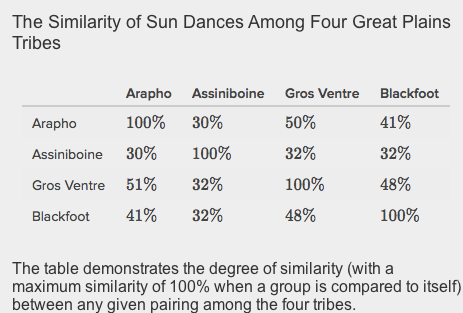Questions 1-11 are based on the following
passage.
This passage is excerpted from Stephen J. Lycett, “Dynamics of Cultural Transmission in Native Americans of the High Great Plains,” ©2014 by Stephen J. Lycett.
As case studies go, understanding the distribution of
cultural elements in Native American communities during the
historical period of the Great Plains would seem a most
challenging one. Famously, there is a mixture of powerful
5 internal and external factors, creating -- for a relatively brief
period in time -- a seemingly distinctive set of shared
elements from a linguistically diverse set of peoples. This is
known across the world as the “Great Plains culture.” [In our
study], quantitative analyses show how different processes
10 operated on two sets of cultural traits among nine High
Plains groups. Moccasin decorations exhibit a pattern
consistent with geographically-mediated between-group
interaction. However, group variations in the religious
ceremony of the Sun Dance also reveal evidence of purifying
15 cultural selection associated with historical biases, dividing
down ancient linguistic lines. The latter shows that while the
conglomeration of “Plains culture” may have been a product
of merging new ideas with old, combined with cultural
interchange between groups, the details of what was
20 accepted, rejected or elaborated in each case reflected pre-
existing ideological biases. Although culture may sometimes
be a “melting pot,” the analyses show that even in highly
fluid situations, cultural mosaics may be indirectly shaped by
historical factors that are not always obvious. . .
25 “Culture” is the conglomeration of information,
knowledge, ideas, and beliefs, shared by communities and
transmitted by social interaction. This shared property
characterizes all human societies. Communities that came to
occupy the High Great Plains during the 19th century
30 exemplify the manner in which humans can take existing
ideas, elaborate them, combine them with new ones, pass
them successfully between groups and create novel, distinct
patterns, visible over temporal and spatial scales. Attempting
to examine the role of specific factors in creating cultural
35 patterning under such historically-contingent, transient, and
dynamic conditions, however, presents a challenge.
Here, analyses have shown the presence of distinct
processes operating and ultimately influencing the
representation of cultural traits in different tribes. Patterns of
40 similarity and difference in moccasin designs among
different tribes show a statistically significant relationship
with the model of geographic relationships between tribes.
No statistical effect of language affiliation on the distribution
of moccasin decorations was detected. This indicates that the
45 representation of moccasin decoration types among groups is,
in this case, most strongly determined by whether or not that
trait is present in another, geographically proximate, tribe. In
other words, selection biases have not disrupted the
distribution of these decorations to the extent that they
50 deviate significantly from a pattern predictable on the basis
of the geographic relationships between tribes alone. These
results would seem to reaffirm the role of intergroup relations
in creating a pattern of shared cultural similarity over the
region during the 19th century, which many have previously
55 discussed.
Behavioral variation between tribes in terms of their
practice of the religious ceremony of the Sun Dance also
indicated a statistical relationship with geography, again
reiterating the role of inter-tribe transmission in creating the
60 phenomenon historically labeled as the “Great Plains
culture.” However, patterns of inter-tribe variation in Sun
Dance elements also exhibited a statistically significant
relationship with linguistic affinities between different tribes.
Ordinarily, this pattern might simply be attributed to the fact
65 that tribes with more mutually comprehensible languages
were able to more effectively transmit the behavioral variants
among themselves. Here, however, language patterns were
found not to correlate with geographic patterns and,
moreover, the statistical relationship between Sun Dance
70 patterning and linguistic affiliation was found to still hold
even when geography was controlled for. The relationship
between Sun Dance variations and language patterns is,
therefore, in this instance puzzling.